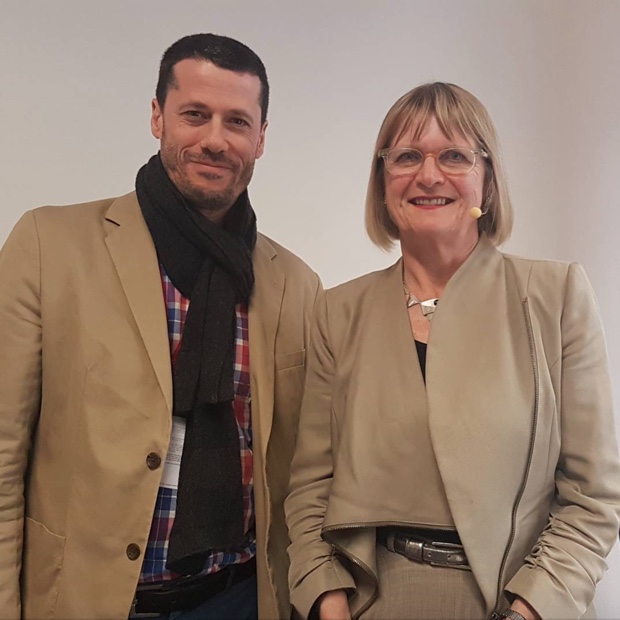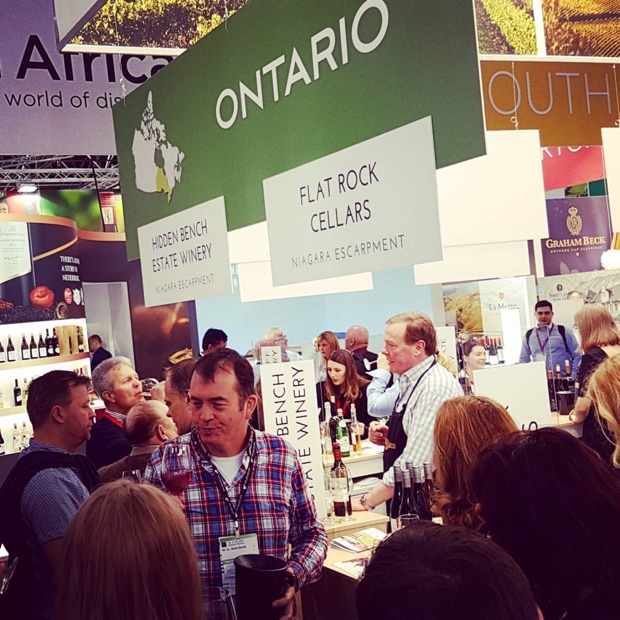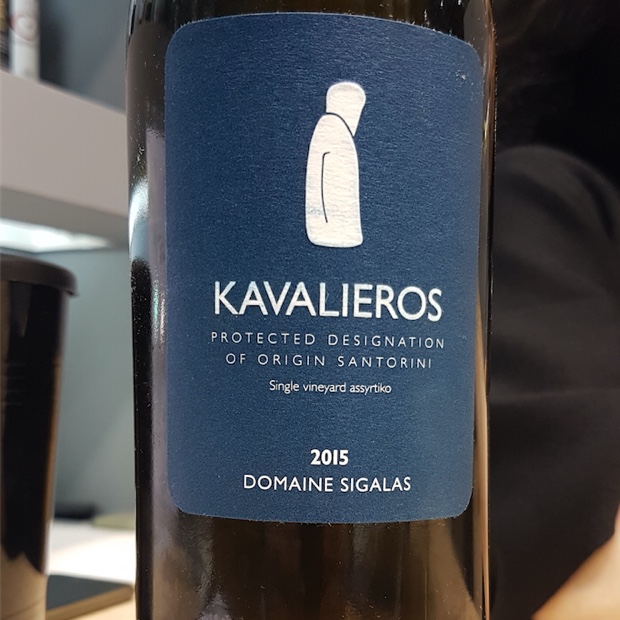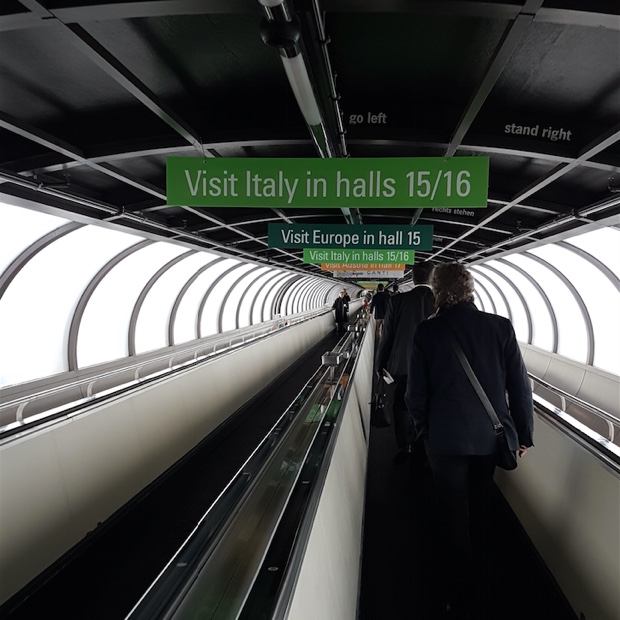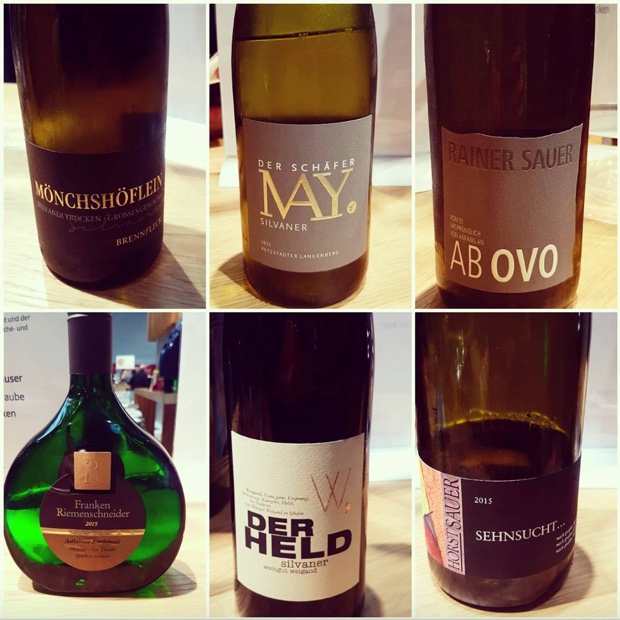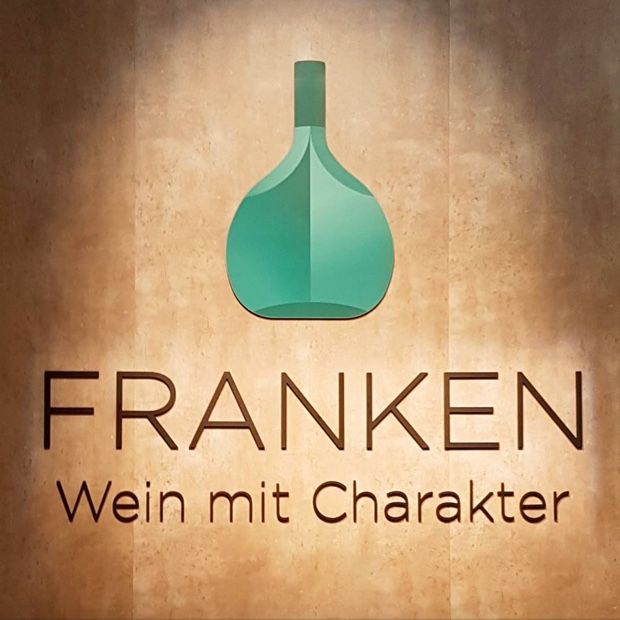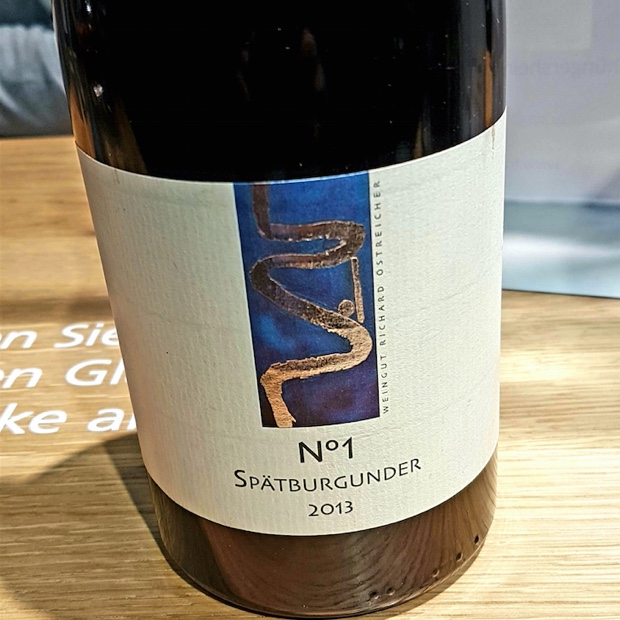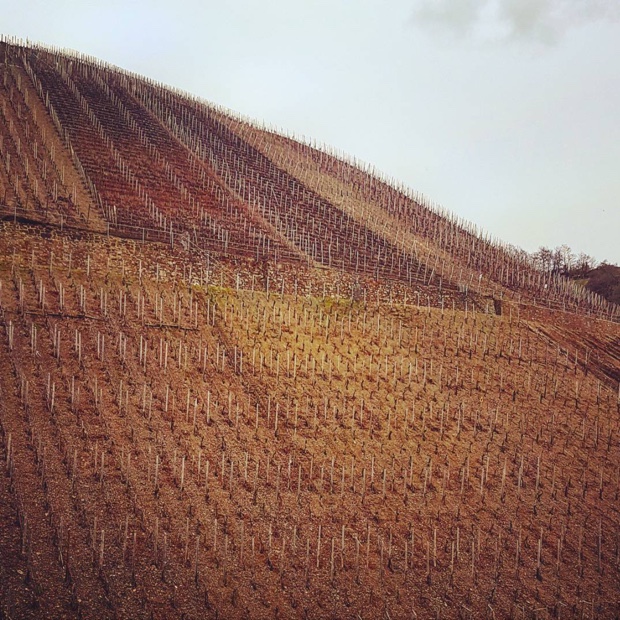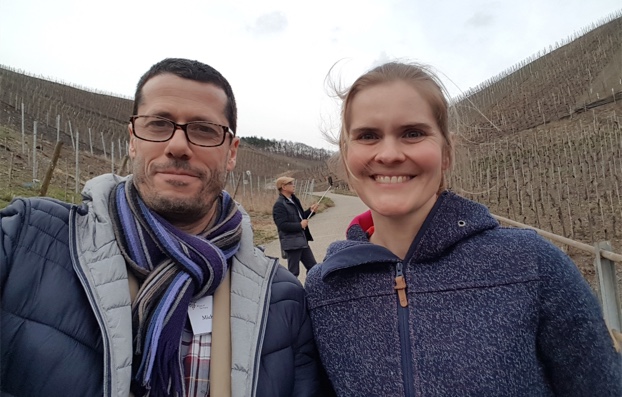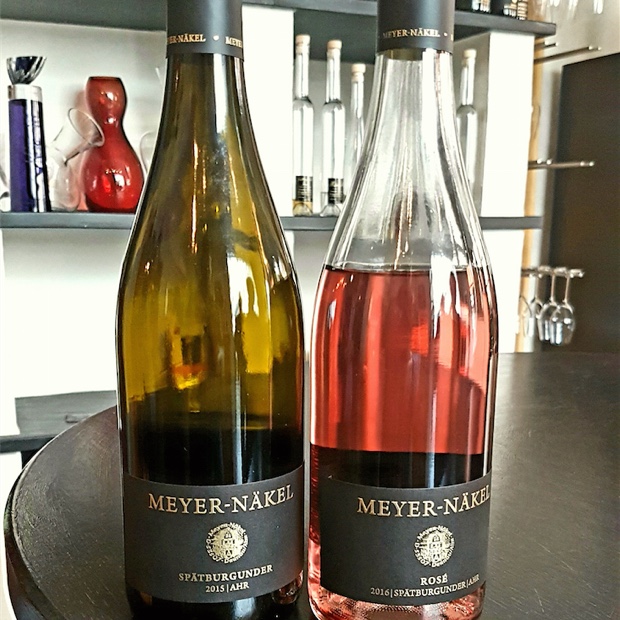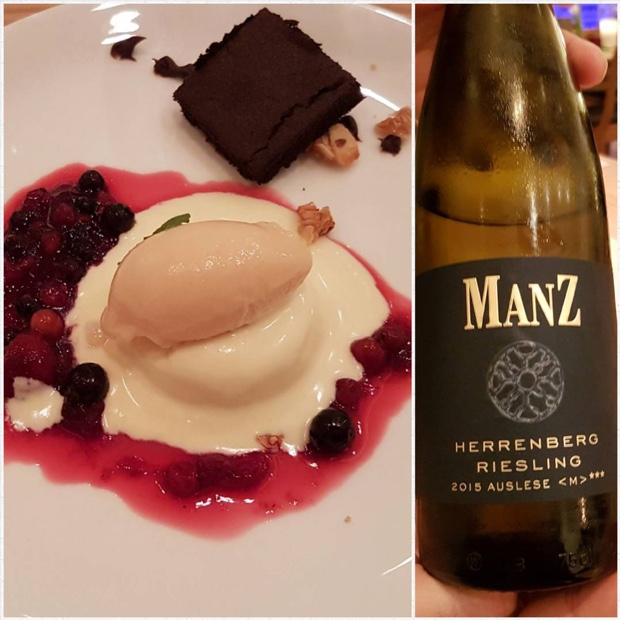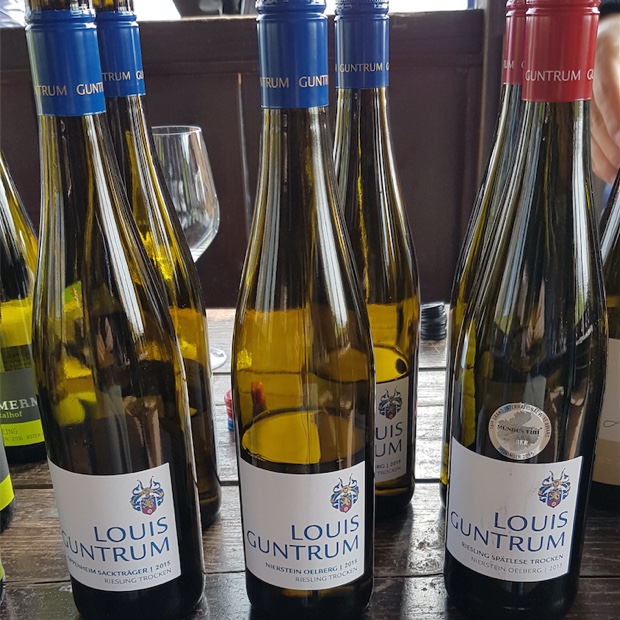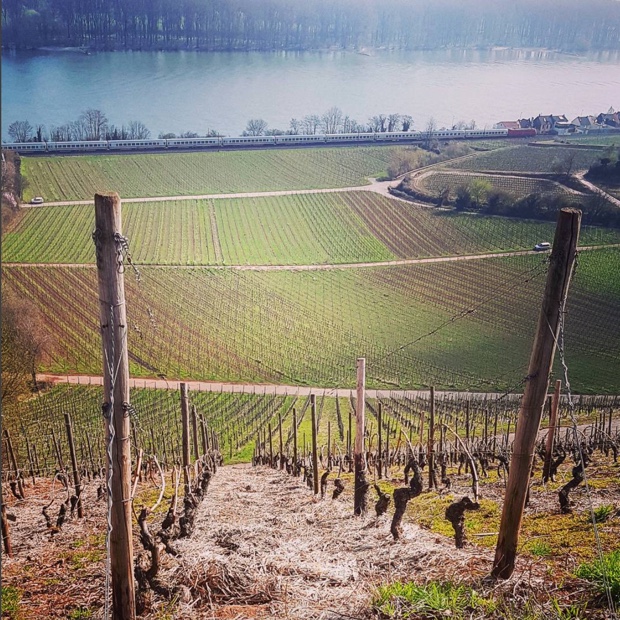as seen on WineAlign
In March I attended Prowein in Düsseldorf, Germany, the world’s largest wine trade fair, tasting a fascinating array of wines. I also added short visits to lesser known regions, first the tiny Ahr Valley as well as Rheinhessen in Germany. Last month I published a brief synopsis report based on the following tastings:
Jancis Robinson, Alsace, Greek Assyrtiko, Chianti Classico, Franken Silvaner, The Ahr Valley and Rheinhessen…
It was one month ago that David and I attended Prowein 2017, the international wine congress in Düsseldorf, Germany of such immense proportion that words, description and explanation just fail to do it justice. If you are an agent your goals are simple; meet with your incumbent suppliers and taste with enough new ones to fill the holes in your portfolio. But what if you are a journalist like me? What do you concentrate on? Were do you start?
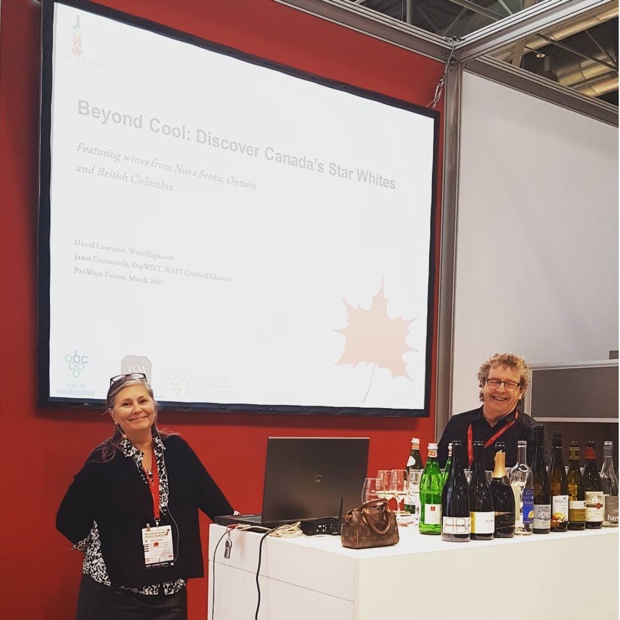
Canada’s two coolest wine cats present the country’s cool whites to a packed #Prowein house #Canadianwine #ontariowine #winesofbritishcolumbia #drjanetdorozynski #davidlawrason #beyondco
First things first. As a Canadian and a representative of Wine Country Ontario I hung around the Canadian pavilion, talked with our coast to coast winemakers, vintners and marketing representatives, took in the seminars on cool climate wines led by David and Dr. Janet Dorozynski and of course, tasted some wines. I’m glad I did because I might have otherwise missed out on four exceptional Canadian bottles.
Pillitteri Estates Winery Cabernet Franc 2013, VQA Niagara Peninsula, Ontario (Agent, $24.95, WineAlign)
The quintessential cool climate vintage does for more than chardonnay and riesling as told by this classic tier cabernet franc. From winemaker Aleksandar Kolundzic who is rapidly developing guru status where cabernet franc is concerned, which comes as no surprise when you consider how many variations on the theme he lends his laser focus. The 16 months spent in two to three year-old oak leads to mellow melting integration and that seasoned, grace-gifting wood is used to great advantage. This is floral, expansive, chewy, firm and so very pretty. A wise old cabernet franc that will tell great stories of the years gone by well into the next decade. Drink 2017-2023. Tasted March 2017 @Pillitteriwines pillitteriwines @PillitteriEstatesWinery @WineCountryOnt winecountryont @mkaiserwine @WineCountryOntario
Vineland Estates Elevation Cabernet 2014, VQA Niagara Peninsula, Ontario (173609, $28.00, WineAlign)
The two thirds/one third cabernet franc/cabernet sauvignon stunner from Vineland Estates is pulled (and now labeled) from the 60-acre Bo-Teek Vineyard found within the designated viticultural area Niagara Escarpment (within the broader Twenty Mile Bench) sub-appellation. Estate cabernet of such acumen is predicated on the sound wisdom gathered by a viticulturist and Vineland’s Roman Prydatkewycz knows his cabernet. Winemaker Brian Schmidt takes this paradigmatic escarpment fruit, passes it through the optimal sorter, removes five to eight per cent imperfect berries and a quarter of the cabernet sauvignon fruit. What remains is hand-punched, sent to neutral barrels and is forgotten for 15 months. What emerges is a naturally sweet, vegetal-void elixir, sharp, focused, fervently nervous, tart and captured as if in a dark vacuum or void. It’s all tied inside snug, concentrated and intense. It’s too early for the burst but it will happen within another 12 months time, followed by a six to 12 year slow release of flavour, texture and descendent development of tannin. Drink 2018-2023. Tasted March 2017 @VinelandEstates @benchwineguy vinelandestates benchwineguy @winery.vinelandestates Brian Schmidt @WineCountryOnt winecountryont @mkaiserwine @WineCountryOntario
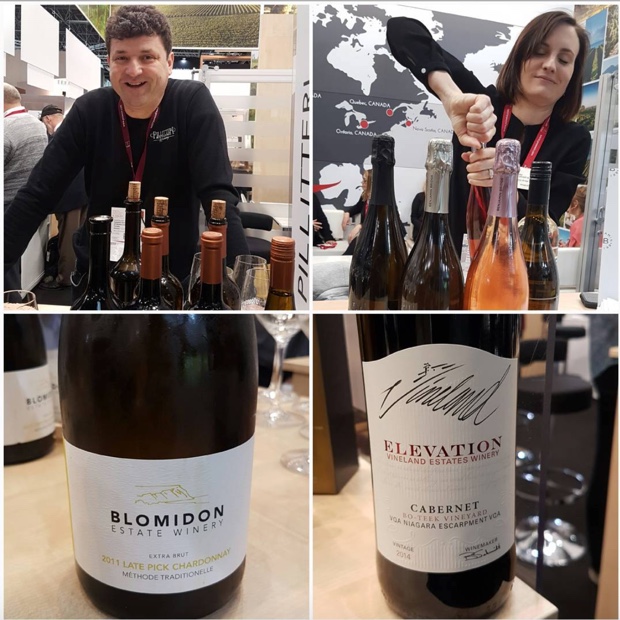
Attention proweiners- Still time to discover cool @WinesofCanada in Hall 9 @CVAWine @WinesofNS #ontariowine #bcwine
Benjamin Bridge Brut Brut Rosé Sparkling 2012, Nova Scotia (Winery, $44.99, WineAlign)
The adjustment for vintage and evolution means that chardonnay takes more control in the Brut Rosé. Warmth and ripeness were easier to come by in 2012 and though the pinot decrease may seem antithetical and not obvious as a result, it is a brilliant stroke of adjudication. With a 43 per cent stake (plus equal parts noir and meunier) the 2012 Rosé rushes out as an open vein of fleshy aromatics, many of which you will have never nosed before. Citrus and floral exotica, like juice vesicles oozing out of fruit and herbal, of Murraya paniculata, pomelo and kumquat. The omnipresent vitality, energy, intensity and Bridge acidity is never denied and definitely not here but the vintage sets this ’12 apart and furthers the experience with travel around excellency. The liquid hits the palate, expands, vaporizes and recurs. It’s magic really, the sparkling wine tasting equivalent of vaping so cue the health benefits. Just when you thought Benjamin Bridge and winemaker Jean-Benoit Deplauriers had hit the mark they turn the mark on its head. Confirms two salient matters; the Nova Scotia sparkling wine leader is the Canadian commander and blush bubbles are what they do with constant consistency. Drink 2017-2022. Tasted March 2017 @Benjamin_Bridge @jbdeslauriers benjaminbridge caveman__jones @benjaminbridgevineyards Jean-Benoit Deslauriers @WinesofNS #winesofnovascotia @winesofns
Blomidon Estate Late Pick Sparkling Chardonnay 2011, Nova Scotia (Winery, $45.00, WineAlign)
The 2011 late-picked chardonnay, the “Hurricane” is a hyperbole of itself. Normally picked in later October, the frost-free weather allowed further time and development. Picked from seaside vineyards just ahead of another hurricane (in a season that included Irene), this is sparkling wine you just have to try. Though lean, taut and as intense as you are likely to taste, the developed character and complexity is visionary for Nova Scotia and Canadian sparkling wine. Three years on the lees brings the texture and fills the gaps, holes and voids created by such a tightly wound cool climate chardonnay. The dry factor is exaggerated in 2011 (a one-off says winemaker Simon Rafuse) but the wine takes full advantage of the Extra-Brut intent. Did it require the anxiety of a recent and an impending cyclone? Can it be duplicated? “That’s the story of the Hurricane.” Visionary for Nova Scotia and Canadian sparkling wine. Drink 2017-2022. Tasted March 2017 @BlomidonEstate blomidonestate @blomidonestatewinery Simon Rafuse @WinesofNS #winesofnovascotia @winesofns
You can’t see it all, do it all or taste it all, so you pick your spots. The rest of my three-day, 12-pavilion cum airport hangar wanderings can be summed up in five ProWein experiences; Jancis Robinson, Alsace, Greece, Chianti Classico and a great exploration into Franken silvaner and spätburgunder. The grand dame of wine held a special intimate media tasting. With fewer than 18 international journalists in attendance, Jancis Robinson’s seven favourite wines at ProWein were poured, choices she noted “I think should be useful to our readers and seek out value.” Nahe and Weinviertel riesling, Chinese cabernet sauvignon, Crozes-Hermitage, Amontillado and my picks of the lot from Chile and Sicily.
Robinson’s full list of wines chosen and poured were as follows: Weingut Schäfer-Fröhlich Riesling Trocken Bockenaur Schiefergestein 2015, Nahe, Germany, Zillinger Grüner Veltliner Radikal 2015, Weinviertel, Austria, De Martino Cinsault Viejas Tinajas 2014, Itata, Chile, Tenuta delle Terre Nere Santo Spirito Rosso 2014, Sicily, Italy, Chateau Changyu Moser Family Cabernet Sauvignon 2013, Ningxia, China, Maison Tardieu-Laurent Vieilles Vignes 2015, Rhône, France, Williams & Humbert Jalifa 30 Year Old VORS Amontillado NV, Jerez-Manzanilla, Spain.
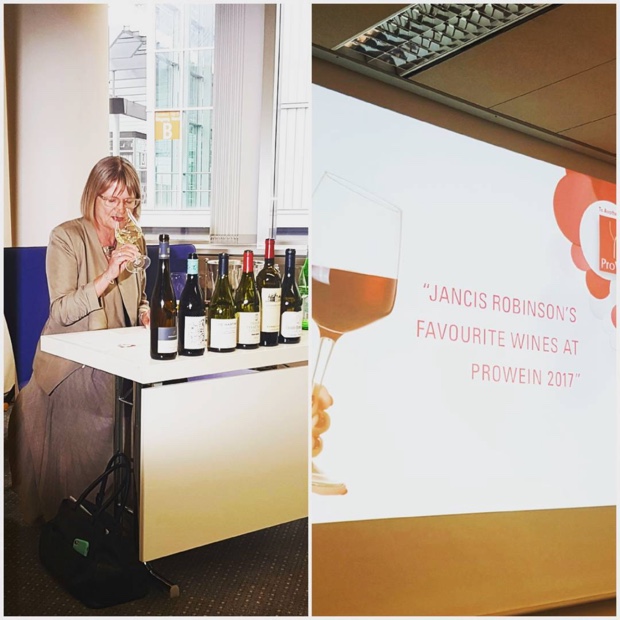
41 years experience. 65,000 to choose from. Seven meticulous picks. @jancisrobinson @Prowein #Prowein
De Martino Viejas Tinajas Cinsault 2014, Secano Interior/Coelemu, Maule, Chile (BCLDB, 72702 $16.99, WineAlign)
Poured by Jancis Robinson at ProWein 2017, the departure for Chile and cinsault hails from just south of Maule and well south of Santiago. Grapes come from a tiny commune called Coelemu and in fact the name Itata cannot be used for ‘un-noble’ grapes so Secano Interior is the nomenclature employed. Done up in old clay jars called “Tinajas,” the cinsault gets a sort of membrane, a cap if you will, of a layer of tannin and acidity due to the clay after 15 days of carbonic maceration plus a full year in those amphorae. The 31 year-old vines deliver the first strike, a natural cure, then bitter cherry and so the wine would service better with a further chill. Robinson notes that it’s “chock full of fruit and tradition,” an exploration wine, in a part of the world not on the bigger maps. Drink 2017-2019. Tasted March 2017 @DeMartinoWines demartinowines @DeMartinoWines @WinesofChile @WinesOfChile drinkchile @DrinkChile
Tenuta Delle Terre Nere Santo Spirito Rosso 2014, Sicily, Italy (Agent, $56.95, WineAlign)
Here is a regional defining Etna Rosso that comes 16 years after the pioneers began to bring these volcanic magma gems to the world, like Frank Cornilessen and Andrea Franchetti of Tuscany’s Tenuto Trinoro in the Val D’Orcia. Made by Marco de Grazie, Santo Spirito is a single vineyard Etna made on the “black lands,” composed of 98 per cent nerello mascalese, deep dark and volcanic, off of 40-100 year old vines. It’s deeply hematic and the nose is like a cross between fennel and the marriage of lava and garrigue. The wine is aged in French barriques and it shows; of vanilla, really mellow liquid bitters. It’s warm (14.5 per cent), young, oak-welling though energetic, playful, like dark modern Burgundy. The finish as so very volcanic twang, like country music, Sicilian style. Such chewy and grainy tannin drapes all over that long finish. Drink 2018-2022. Tasted March 2017 @tenutaterrenere @WinesSiciliaDoc @WinesOfSicily @GroupeSoleilTO tenutaterrenere winesofsicily realbenhardy @TenutaDelleTerreNere @WinesOfSicily
The honour and privilege to taste Alsace is always welcome and especially when the sit down happens with two exceptional humans like Christian and Valerie Beyer. Their Lieu-Dit pinot gris and noir were terrific examples but it was the Riesling that blew me away. From special limestone this is more refined than similar Alsace from granite, of a salty minerality and intensely elegant.

An @AlsaceWines reconnect with Christian & Valérie Beyer @EmileBeyer @Prowein #justlikestartingover #eguisheim #riesling #rieslinggrandcru #pfersigberg #pinotgris #lieudit #hohrain #pin
Emile Beyer Riesling Grand Cru Pfersigberg 2012, Ac Alsace, France (Winery, WineAlign)
The Pfersigberg or “hill of peach trees” consists of limestone conglomera Muschelkalk and Jurassic stone. Its south exposure on very deep soil produces early maturing wines but from the exceptional 2012 vintage Christian Beyer’s Pfersigberg will last a decade or more. His family’s domain has been farming organically since ’05, officially since ’12 and half of the producers in Egusheim are indeed organic. Christian explains that this Grand Cru is a special kind of limestone, so similar to Burgundy and it lends the salty minerality of itself. Always carries richness with lime fresh citrus, stone fruit acidity and some honey in a riesling that will turn waxy in secondary life. It’s really about mouthfeel and the crisp crunchy rock salt so I and I believe you should really concentrate on the aftertaste. This is more refined than similar Alsace from granite, here from 35-45 year old vines and 35 hL/L yields. Intensely elegant. Drink 2018-2028. Tasted March 2017 @EmileBeyer emilebeyer1580 Emile Beyer Valérie Beyer @VinsAlsace @AlsaceWines @drinkAlsace vinsalsace drinkalsace @vinsalsace @AlsaceWinesOfficial
I also sat down with Panayiota Kalogeropoulou and Margarita Damigou for a ProWein date with assyrtiko and it was a revelation to taste a single-vineyard white that turns the world on its head.
Domaine Sigalas Kavalieros 2015, Santorini, Greece (Agent, SAQ 11814421, $31.00, WineAlign)
I’ve not yet tasted the Kavalieros 2014, so this single-vineyard, 18 months on lees done in stainless steel Kavalieros 2015 made by “Mr. George” is the benchmark for Santorini, assrytiko and salty white wines everywhere. The first release was 2009. Straight up and turning the world on its head, like the old man on the label and upside down against Apollo’s Aegean Cyclades. This ’15 richer still, more than the seven villages wines and a hyperbole as compared to the entry-level assyrtiko, of deeper mineral, compressed, layered and fantastic. Crushed rocks permeate in aggregate, it’s quixotically saline and textured, of intense presence and finally, structured. For 15 years at least. A late shot of natural Santorini tonic swirls in centrifuge with assyrtiko so wound up. This will need 10 years to unwind and allow for cracks to form in the mineral shell, followed by the birth of its fruit. It should never be forgotten that assyrtiko can and will show fruit but with Kavalieros you’ll have to be patient. Drink 2020-2031. Tasted March 2017 @DomaineSigalas @MajesticWineInc domainesigalas @DomaineSigalas Panayiota Kalogeropoulou @DrinkGreekWine winesofgreece @newwinesofgreece
As does a natural Peloponnese Roditis, a white that ignites the light fantastic’s wire.
Domaine Tetramythos Roditis 2015, PGI Peloponnese, Greece (Agent, WineAlign)
Roditis 2015 is the natural one, racked from the top and finally now settled (so at this time of tasting 2016 is not yet in bottle but at this time of writing should already be as it always does in April). This is the cleanest and purest of the natural wines on the planet, low in pH, high of natural acidity and without a care in the world. With nothing to fear in regards to spoilage it can go on its own personal shopping spree, accumulate character, personality and confidence with the end result being that there is more of everything in the natural one. Its terrifically repeatable, replicable and clonal acidity makes it quite trippy, stepping on and igniting the light fantastic’s wire. You just have to take a stab in the dark with winemaker Panayiotis Papagiannopoulos’ roditis. Or ye have not yet lived. Drink 2017-2021. Tasted March 2017 @Tetramythos #tetramythoswines @tetramythoswines Devon Masciangelo @DrinkGreekWine winesofgreece @newwinesofgreece
A roam through the Italian pavilion afforded tastings in Puglia, Sicily and as always Tuscany with a one on one face to face with Chianti Classico’s President Sergio Zingarelli and his estate’s flagship wine.
Rocca Delle Macìe Chianti Classico Gran Selezione Sergio Zingarelli 2012, Docg Tuscany, Italy (Agent, $122.95, WineAlign)
This is the flagship wine from the famed estate, a Gran Selezione that bears the patriarchal Sergio Zingarelli name. As expected it is a richer, deeper and depth welling GS, clearly aimed towards the crowning achievement of place, more hedonism, but of course, seeking purity and elegance. The extra year or two in bottle means integration and wood having subsided a bit. “We decided to change the vineyard in 1974 in front of Rocca to be the best vineyard with the best grapes and we will produce our best wine,” I am told by Zingarelli as we taste at ProWein. What was 90 per cent sangiovese (planted in 1999-2000) this 2012 is accented by colorino but in 2014 it will be 100 per cent sangiovese. Elegant as much as sangiovese and Gran Selezione will likely ever strive to be. It is hard not to be impressed with this wine. It bursts with the essence of plums and richest of red cherries, but it’s not without it’s requisite crunch and chew. The absence of astringency is remarkable and speaks to the quality of the fruit and the gentle touch while working with such phenolic ability. Start drinking this anytime. Drink 2017-2025. Tasted March 2017 @roccadellemacie @roccadellemacie @ProfileWineGrp Profile Wine Group roccadellemacie @chianticlassico chianticlassico @ChiantiClassicoUSA
Cantina di Ruvo Grifo Nero di Troia Riserva Augustale 2012, DOCG Castel del Monte, Puglia, Italy (Winery, WineAlign)
Grifo in Castel del Monte was established in 1960 as a cooperative, with 400 farmers and still operates as such with flagship wines based on the local nero di troia. The output is quantified at 1,200,000 bottles per year and increasing. Augustale is the top tier varietal wine from a selection of the vines and produced in small quantities. There is no mistaking what it is, with that specific yeasty bright fruit, slightly volatile to funky but ripe and generous grape scent and bursting with flavour. Spent approximately one year in oak “but the greatest liars are the winemakers,” says Riccardo Ravasio, Direttore Generale presso (General Manager), with a wink and a smile. Mainly big barrels, plus a smaller percentage of small barriques. Fresher than primitivo and with more structure. This has presence and distinction with just a hint of dried fruit, flowers and truffle towards the finish. Classic adult, mature, experienced NdT. Drink 2018-2022. Tasted March 2017 #Grifo @FedericaSchir @cantinaruvodipuglia

Miracle on #etna from @PlanetaWinery eruptive #carricante of such acidity! The lime! #eruzione #1614 #patriciatoth #prowein2017 #winesofsicily #Prowein
Planeta Eruzione 1614 Carricante 2014, Doc Sicily, Italy (Agent, $39.95, WineAlign)
“Not everyone can carry the weight of the world,” save perhaps Planeta’s Patricia Tóth, a winemaker who celebrates the past, the endemic varietal and in the present, the glaring truth. The name Eruzione is evocative of the estate’s Cru dell’Etna and in a mind’s eye transports history through the narrative of carricante (with 10 per cent riesling). It brings the legendary 1614 Mount Etna eruption to life, a longest ever recorded catastrophe that lasted ten years, halting just on the border of the vineyards of Sciaranuova. This is veritable mountain altitude wine, from high (790-890m) terraced, volcanic black soils delivering fresh conifer savour, saltiness and palpable mineral style. It is sharp and composed on the nose, with citrus distillate and elevated acidity. It does not matter whether you are wide awake or deep in R.E.M sleep. At all times it is a revelation for carricante. This is what it can be! There was no need for crop thinning, it was picked four to five weeks after the sparkling and it spent five months on the lees. The texture and the potential longevity are thankful for this. “Combien, combien, combien du temps?” At least seven years. Talk about the passion. Drink 2018-2025. Tasted March 2017 @PlanetaWinery @Noble_Estates planetawinery plant dependent noble_estates @planetawinery Tóth Patricia @NobleEstates

No self-respecting wine journo departs #Prowein without tasting #carricante @PlanetaWinery with #patriciatoth #etna
The Germany pavilion is the epicentre of the ProWein universe. Gravity would naturally pull you to the Mosel and yet I was in search of an alternative experience. With travels to the Ahr Valley and the Rheinhessen looming I gravitated (naturally) to Franken and more specifically to an intensive workshop with silvaner and spätburgunder. The days of the old flattened ellipsoid, field bottle silvaner packaged in traditional Franconian Bocksbeutel are nearly behind us and while several modern, clean and pure examples match up with the great mineral fresh whites around the planet, one stood apart.
Rudolf May Silvaner Retzstadter Langenberg Der Schäfer 2015, Franken, Germany (Winery, WineAlign)
May’s Der Schäfer silvaner comes from the Retztadter Langenberg, a slope of muschelkalk (predominantly from the lower muschelkalk, or wellenkalk) that characterizes the soil. Looking east the location is protected by the Retzstadt deciduous forest and the warm air of the Maintales flows from the west. This specialized and extra-special silvaner is balanced in its aromatic ability meets proper and right-willing alcohol (13.5), with great quality acidity. True salinity and caper brine put my mind’s senses into concepts where this shares a kinship with assytrtiko. It’s brilliant, stony-gemstone able, savoury, no actually sapid, and exceptionally mouth salivating. Just a touch of texture driven lees builds character and great persistence. Bitters before the end are finely distilled and character building. Fresh to drink now and with more ability than most to age. Drink 2017-2022. Tasted March 2017 @frankenwein #frankenwein Frankenwein Fränkische Weinkönigin @Weingut.Rudolf.May @weininstitut @WinesofGermany @germanwineca germanwine_ca wines_of_germany @germanwinecanada
Passion für Pinot Noir! is the avant-garde Deutscher Qualitäswein Franken slogan for spätburgunder. Rudolf May once again impressed with their Retzbach Benediktusberg but as I was about to pour myself a taste of the next wine, a Franken booth associate swooped in to slip me a Burgundy glass, so I knew this was going to be different. It was the next wine that taught me what Franken pinot noir can be.
Weingut Richard Östreicher Spätburgunder No. 1 Sommeracher Katzenkopf 2013, Franken, Germany (Winery, WineAlign)
No. 1 takes not only the estate’s best pinot noir pick but Franken spätburgunder and paradigmatic pinot noir to an entirely new level. The Katzenkopf (“cat’s head”) is Sommeracher’s best vineyard and it is Weingut Richard Östreicher that demands great respect. As I am about to pour myself a taste a ProWein Franken booth associate swoops in and slips me a Burgundy glass, so this must be different. Certainly an elegance and a refinement not seen yet. I’m thinking only on its perfume from the get go but this Franken sensibility is more important, a soil component that just acts of its own accord in the magic it brings to pinot noir. The compatibility of fruit and acidity with the finest grains of sweet and refined tannin is a revelation. The vintage is an important one to be sure and the firm but still amenably sweet finish mixed with a dash of tonic tells me about the longevity this No. 1 is capable to execute. Drink 2017-2027. Tasted March 2017 #richardöstreicher Richard Östreicher @weininstitut @WinesofGermany @germanwineca germanwine_ca wines_of_germany @germanwinecanada
On day three of ProWein I jumped on the großer Magie Bus with 17 international journalists and headed for the Ahr Valley, one of Germany’s (of 13) furthest northern wine regions. With an area of 150 hectares (of 100,000 total in Germany), even the Mosel is not so far north. Our first visit was to Meyer-Näkel, a young winery in its third generation. Before that there was a winery (Meyer) and Näkel (restaurant). When the grandparents married the entities merged. In 1982 winemaker Meike Näkel’s father took the winery and her uncle the restaurant.
Starting out with two, now there are 20 hectares under vines. The slopes are ridiculously steep, prized for their blue slate soils and so difficult to work. Spätburgunder steals the Ahr Valley show and while Meyer-Näkel’s lieu-dit and grand cru (Großes Gewächs) are impassioned and important works, in Ontario you can find their affordable entry-level treat. It really is what basic German spätburgunder needs and is expected to be.
Meyer Näkel Spätburgunder 2015, Deutscher Qualitätswein, Ahr Valley, Germany (427898, $26.25, WineAlign)
The entry-level pinot noir was bottled in the summer of 2016, after a hot season and dry elsewhere but in the Ahr it rained and it was cool overall. Picking was actually late and the aromatics show off the long, cool, floral temper. De-stemming and fermentation is immediately initialized but the maximum fermentation is 10 and usually six days. The pips are just a quick doo-wop to keep both green and bitter away. A focus on fruit, an absence of tannin and a pure varietal expression. Red trumps green, large wooden casks (15-20 years) also impart no tannin so the finality is simply cherry. That said, this carries some almond pit and green strawberry on the palate. It’s really what basic German spätburgunder is and expected to be. Nicely balanced and in at 13 per cent alcohol. Drink 2017-2019. Tasted March 2017 #MeyerNäkel @vonterrabev Weingut Meyer – Näkel vonterra @MeyerNaekel @weininstitut @WinesofGermany @germanwineca germanwine_ca wines_of_germany @germanwinecanada
Yet nothing could prepare me for what a former German wine queen would pour. Julia Bertram grew up in Dernau, gained experience at Meyer-Näkel and Klumpp. In 2013 she launched her own her vineyard with just half a hectare and now farms three and a half. Nothing fascinates her and the “SchlAhrVino” (association of young Ahr vintners) as much as ripe wines, especially pinot noir. Her whole bunch, wild ferment spätburgunder is nothing short of intense. The world should get ready for her alternative Ahr universe.
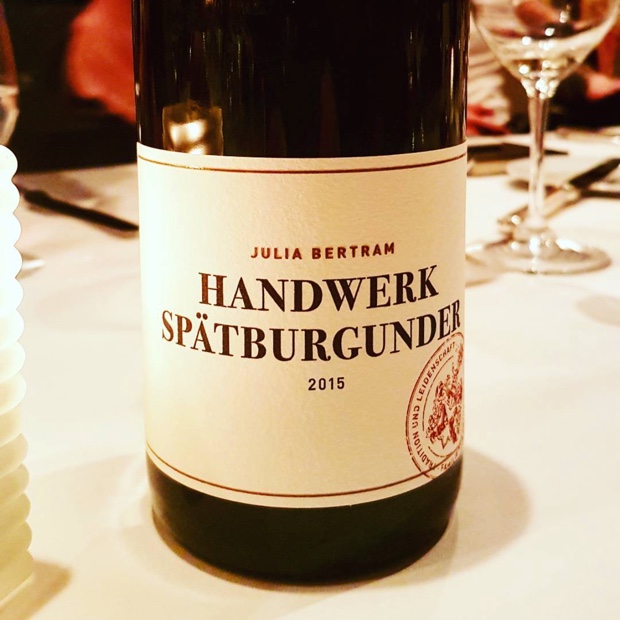
World get ready for #juliabertram and her alternative #ahr universe pinot noir @weininstitut #ahrvalley #spätburgunder #handwerk
Julia Bertram Spätburgunder Handwerk 2015, Ahrweiler, Germany (WineAlign)
Former German Wine Queen Julia Bertram grew up in Dernau, gained experience at Meyer-Näkel and Klumpp. In 2013 she launched her own her vineyard with just half a hectare and now farms three and a half. Nothing fascinates her and the “SchlAhrVino” (association of young Ahr vintners) as much as ripe wines, especially pinot noir. Her whole bunch, wild ferment spätburgunder is nothing short of intense. Bone dry, tart and spirited by crisp acidity, the young vines and used barrels deliver notes that are embattled in a spontaneous, natural, posit tug. The world should get ready for her alternative ahr universe pinot noir. Drink 2017-2020. Tasted March 2017 #juliabertram #juliabertram Julia Bertram @weininstitut @WinesofGermany @germanwineca germanwine_ca wines_of_germany @germanwinecanada
The next two were Rheinhessen days, first with five Appenheim village winemakers at Weingut Willems & Hoffman, followed by a visit to taste more deferential and singular spätburgunder at Weingut J. Neus. The single vineyard of Hudertgulden in Appenheim is one of the Rheinhessen’s finest. At Neus we got grippy with the muschelkalk soil meets spontaneous ferments from the team of Operations Manager Lewis Schmitt and agronomist/oenologist/winemaker/cellarmaster Julien Meissner’s pinot noir.
Weingut Knewitz Riesling Hundertgulden 2015, Rheinhessen, Germany (WineAlign)
From the Burgundy-like soils of this special rolling hills nook in the Rheinhessen, replete with shells and corrals, the Hundertgulden, “hundred guilders” is the most important single vineyard in all of Appenheim. The vintage trumps 2014 and nearly bone dry is still the operative in this super salty, linear, lengthy and age-worthy riesling. A true blue limestone vernacular is spoken and the stone simply slides and glides through the wine. Definitive of place, with leesy texture, elegant, balanced and seamlessly woven through. There is more lime zest and juice than the Appenheimer and more overall citrus tendency. The mirror of Appenheim. Drink 2018-2022. Tasted March 2017 #weingutknewitz weingutknewitz @Weingut.Knewitz @weininstitut @WinesofGermany @germanwineca germanwine_ca wines_of_germany @germanwinecanada
Weingut J. Neus Spätburgunder Muschelkalk Alte Raben Trocken Ingelheim Am Rhein 2014, Rheinhessen, Germany (WineAlign)
From vines 25-40 years old, depending on which barrels are chosen for the final blend, off of the estate’s singular limestone muschelkalk soils. Even some 45 year-old vine fruit can be used, ferments kept separate, just as winemaker Julien Meissner will do with the Großes Gewächs. After tasting the younger vines spätburgunder and trocken first this acts less up front fruit forward, now spirited, of a phenolic tonic, variegated, characterful, open and spontaneous. Large (600 and 1000L) 100 per cent new oak barrels add char and spice to the rampant cherry, but also structure that takes you on the ride from background to foreground. “A strict style of pinot noir,” says Meissner, a cellar master who triples as agronomist and oenologist. Reduction begs for patience and time, tannins are taut and there is this minty, Mornington Peninsula pinot effect. Fruit, tannin, chalk and the conduit of Neuss acidity. The whole package. Drink 2018-2022. Tasted March 2017 @JNeus1881 jneus.ingelheim @J.Neus.Weingut.seit1881 @weininstitut @WinesofGermany @germanwineca germanwine_ca wines_of_germany @germanwinecanada
We moved away from the red wine thematic and into more familiar territory when we stopped in at Weingut Thörle for a visit with Christoph Thörle. The single-vineyard Hölle and Schlossberg rieslings are as exceptional as any in Germany but the Ontario presence of the Feinherb should never be overlooked.

Some of Germany’s finest #riesling coming to @TerroirTalk May 29th #thorle #Terroir2017 #christophthorle #saulheim #rheinhessen #terroirsymposium #holle #agotoronto
Thörle Riesling Feinherb 2016, Qualitätswein Rheinhessen, Germany (420091, $18.95, WineAlign)
Off-dry riesling does not always have to be bottled as such but in the Rheinhessen and at Thörle the category of Feinherb is anything but an afterthought. This started as a side fermentation in its first years but is now an important wine in the estate’s multi-tiered processes. The cuvée is gathered from younger vines plus one barrel of premier cru Saulheim fruit. A slight skin maceration (12-18 hours) is employed which helps to temper the tartaric acid though this will be swapped for whole bunch fermentation in warmer years. Hides some of its sugar, especially on the nose which is quite floral, of white flowers and honeysuckle. Honey and wax with sweet herbs bring all into playful light to taste, with plenty of sweet lime and lik-a-maid sour touches. For every Indian Food list in the world. Drink 2017-2020. Tasted March 2017 Weingut Thörle @WeingutThoerleGabsheim @weininstitut @WinesofGermany @germanwineca germanwine_ca wines_of_germany @germanwinecanada
On our last day in the Rheinhessen we stopped in at Weingut Manz and if you ever find yourself in their tasting room, expect a multi-varietal experience. On any given day you may taste weissburgunder (pinot blanc), riesling, grauburgunder (pinot gris), sauvignon blanc, spätburgunder (pinot noir), merlot, cabernet sauvignon and finally, huxelrebe trockenbeerenauslese. On this day it was the wines spoke to the territorial low yields and late harvest work of Eric Manz.
Weingut Manz Riesling Spätlese Trocken Kehr, Weinolsheimer 2015, Rheinhessen, Germany (WineAlign)
The Kehr from Eric Manz is riesling of extremely low yields and a late harvest for what shines to be high in complexity and aging potential. Generous skin contact and even more so in lees action effect makes this quite different than the Kehr “M” but also the Herrenberg Trocken Spätlese. With the sugar here remaining in line with the Hipping (Niersteiner) it is the high acidity that drives the Kehr machine. This seems less arid than the Hipping, more energetic and more reductive than the “M.” Higher potential for aging with so much lime cordial sparkles and brings spirit that will persist into a petrol and honey future that would have to be bright. Drink 2019-2026. Tasted March 2017 #weingutmanz Weingut Manz Weinolsheim @weingut.manz.weinolsheim @weininstitut @WinesofGermany @germanwineca germanwine_ca wines_of_germany @germanwinecanada
The week in Germany saw virtually no sun, that is until the final morning outdoors above the Rhein River under the shelter of the Fockenberghütte. Here we tasted the Nierstien wines of Weingut Domtalhof, St. Antony and Louis Guntrum with our charismatic M.C. Konstantin Guntrum. We walked the famed Roter Hang Vineyard and had the great fortune to taste Guntrum’s ethereal 1976 Neisteiner Heilgen riesling. Guntrum wears the passion for his home vineyard in his expression, on his sleeve and by the way he walks. “Roter Hang is a geological statement,” he explains. Red soils of friable sandstone, steep and breathtaking. Nierstein is the portal into which you can peer to wonder about great riesling grown above the Rhein.
Weingut Louis Guntrum Riesling Trocken Nierstein Oelberg 2015, Rheinhessen, Germany (WineAlign)
Nierstein’s Oelberg is for vintner Konstantin Guntrum a changing landscape, of different light and greater fog. This dry riesling gives off the sense of intelligence and so grabs your attention and demands your concentration. It also solicits conversation. Takes its time to open up, with no petrol note but the grace of mineral is back there. Lean but slowly changing and developing in just the short time in glass, the charm envelops your sense of smell and taste, renders them keen and then you give it up for the aftertaste and the persistence. While the layers will not yet peel away they will, though may need two full years to do so. Forget the need for immediate gratification because this one is mineral skin deep. Drink 2018-2024. Tasted March 2017 @LouisGuntrum #louisguntrum Weingut Louis Guntrum @weininstitut @WinesofGermany @germanwineca germanwine_ca wines_of_germany @germanwinecanada
The German wine experience is owed great thanks to Stefan Egge, Christiane Schorn, Brigitte Küppers, Michael Mandel and Carola Keller of ProWein press department, Messe Düsseldorf and Wines of Germany. I have been on many Press trips over the years and the organization in Germany was second to none. I will now begin looking forward to ProWein 2018. Until then.
Good to go!
Godello
Twitter: @mgodello
Instagram: mgodello
